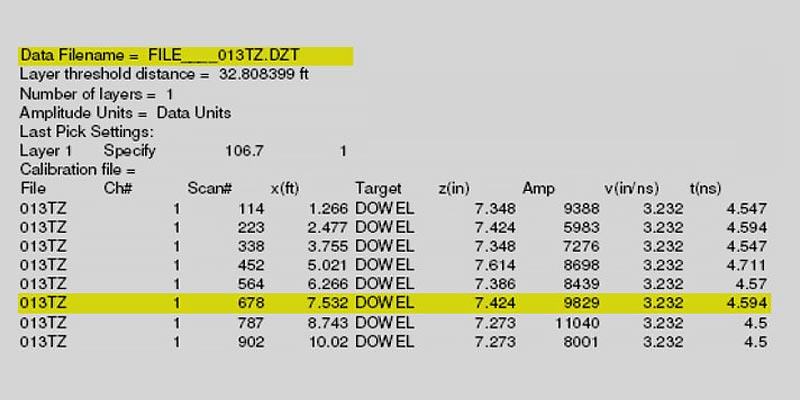Background:
 Ground penetrating radar wave time travel is the only direct measurement taken by our GPR equipment in the field. Depths or distances to embedded dowel bars can only be obtained by a physical measurement from a drill hole or coring. When both time and distance are known from these two direct measurements, the average velocity of radar wave propagation with in the concrete medium can be determined accurately. This accurate depth velocity determination can then be applied to all gpr profiles in the survey. This method is termed the “reflected wave method”, and requires that the radar imaging and wave energy is reflected from the embedded dowel that has been directly measured.
Ground penetrating radar wave time travel is the only direct measurement taken by our GPR equipment in the field. Depths or distances to embedded dowel bars can only be obtained by a physical measurement from a drill hole or coring. When both time and distance are known from these two direct measurements, the average velocity of radar wave propagation with in the concrete medium can be determined accurately. This accurate depth velocity determination can then be applied to all gpr profiles in the survey. This method is termed the “reflected wave method”, and requires that the radar imaging and wave energy is reflected from the embedded dowel that has been directly measured.
Sample of Findings:
Note that the direct field measurement for the sixth dowel in profile 013 was field measured at 7.5” in depth, and the average velocity calculation derives a depth of 7.424”. The difference in the two depths stated is well with in the ¼” tolerances of the GPR collection system. The physical point on the dowel at which the field measurement is taken, is often scored by the carbide drill bit and may not be exactly in the center of the circular rebar. The averaged velocity depth calculation logarithmically searches for the highest amplitude value of the closest point of the circular rebar to the receiving antenna. It is not uncommon to find that the averaged velocity depth calculations to be more exact than the direct field measurement.

